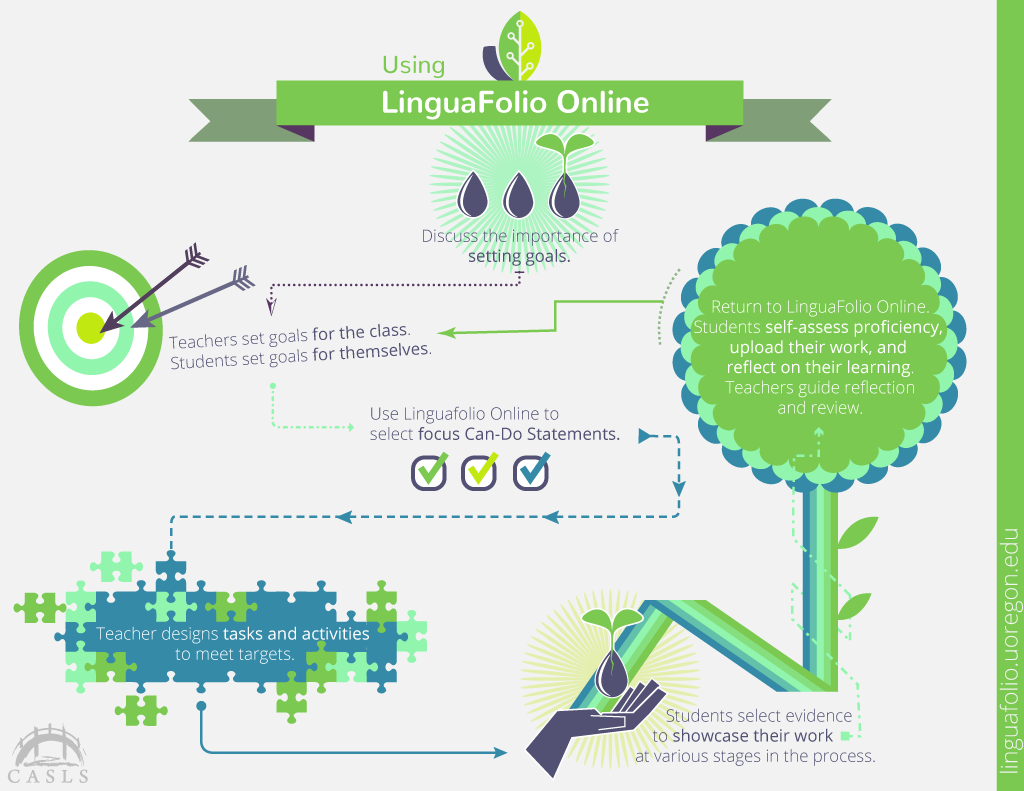The LFO Design Cycle
The graphic above outlines how educators should design their classrooms in order to effectively implement LinguaFolio online. It is broken down for you in the sections below.
Goal Setting with LinguaFolio Online: Selecting Can-Do Statements
Meaningful learning is encouraged through the selection of appropriate learning targets. These targets are set forth by the NCSSFL-ACTFL Can-Do Statements (2015 NCSSFL-ACTFL Can-Do Statements, 2017 NCSSFL-ACTFL Can-Do Statements for Interpretive Communication, 2017 NCSSFL-ACTFL Can-Do Statements for Interpersonal Communication, 2017 NCSSFL-ACTFL Can-Do Statements for Presentational Communication, 2017 NCSSFL-ACTFL Can-Do Statements for Intercultural Communication) and any customized Can-Do Statements that LFO users create. Selecting the appropriate learning targets requires intentional and thoughtful backwards design from educators and a true understanding of goal setting from learners. In order to help learners to understand goal setting, we have developed a Learner Goal Setting Handout to review in the classroom.
We also have developed many resources designed to help walk educators through the backwards design process. The first is our Can-Do Planning Worksheet, a handout designed to help users to consider all Can-Do Statements that might be relevant to an assessment at the end of a unit of study. This worksheet is designed to complement the planning process exemplified by our Unit Planner. The implementation of both of these documents is discussed in detail in the module below.
Do you need some more help with unit planning? This video provides an overview of the unit planning process and how to incorporate LinguaFolio Online while planning instructional units. You’ll hear about an online Chinese course that utilizes Can-Do Statements as learning objectives.
Assessment with LinguaFolio Online: Implementing LFO as a Meaningful Formative Tool in Your Classroom
After educators set goals for their classrooms, they must design activities to match the goals that they have set forth. This process involves outlining a clear final unit assessment by using our Unit Planner and a rubric of some sort (please see Novice Presentational Communication Rubric for an example rubric). The process of designing this final unit assessment is described in detail in the module below (please note that this video will be updated shortly to reflect the terminology in our newest unit planner).
After designing a clear final unit assessment and its expectations, educators must intentionally plan day-to-day activities that allow students to develop their skills towards achieving the learning targets set forth by the Can-Do Statements selected. The process of doing so is described in detail in the module below.
Creating Evidence for LinguaFolio Online
In order for LFO to be an effective tool, learners must create evidence that showcases language proficiency rather than solely their knowledge about a language. In other words, LFO is designed to capture what learners can do with language. Please consider these evidence examples when you design tasks to help learners to create evidence. The creation of this evidence is discussed in more detail in the module below.
Reflecting on Evidence Uploaded to LinguaFolio Online
Though it is difficult to fit into class time, it is imperative that educators give their learners the opportunity to reflect on their work. Without doing so, the integrity of LinguaFolio as a formative assessment tool is undermined. More supports related to reflective practices are coming soon.
What’s next
After learners and educators have the opportunity to reflect on the evidence uploaded to LinguaFolio Online, they must both work to establish new goals for learning based on the learners’ performance. At this point, the LFO design cycle begins again.

